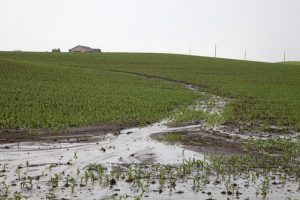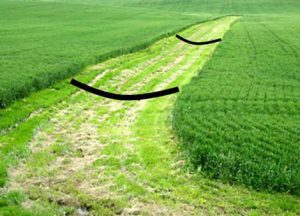Ernie Aust was one of the most unique NRCS employees I have had the privilege of working with. Ernie was special. He served as Area Conservationist in Southwest Iowa and I was fortunate to have him as a supervisor. Looking back, it is obvious Ernie missed his calling. His talents would have been better utilized as an engineer or resource conservationist. During our professional visits, Ernie had little interest in talking about performance appraisals and workload analysis; instead he wanted to talk about engineering practices and variations that could achieve better conservation. He loved to debate how a practice design could be modified so as to enhance resource management.

One day early in our relationship, Ernie and I had a particularly intense discussion about the form and function of a grassed waterway. As a young pup with the Soil Conservation Service (later renamed the Natural Resources Conservation Service), I was taught a grassed waterway should be designed so that any sediment carried within the water should be deposited somewhere downhill, beyond the field boarder; somewhere like the neighbor’s field or maybe even a stream or river.
The rationale for moving the sediment beyond the waterway was, and still is, to prevent excessive sediment from being deposit within the grassed waterway. This sediment causes the waterway to lose shape, reducing its capacity to carry water, which results in a need to spend money to re-shape the waterway. Well that was conventional wisdom, not Ernie Aust wisdom.

For Ernie, grassed waterways could provide more than just soil erosion benefits – they could also be designed to filter sediment from the water flowing through it. Ernie argued that grassed waterways could be designed to trap sediment, rather than passing the sediment downstream. As I later came to realize, this slight design modification was brilliant.
By design, a grassed waterway is used to reduce ephemeral erosion (Figure 1). Waterways are usually designed to be a broad and shallow vegetated channel with the purpose of moving surface water downslope across farmland without causing ephemeral erosion. Then, as water travels down the waterway, the design and vegetation prevents ephemeral erosion that would otherwise result from concentrated flows.
By Ernie’s calculations, a carefully designed waterway could probably trap a higher percentage of sediment, per linear foot, than a traditional filter strip along a stream. He argued that in order for waterways to trap sediment, they would need to be built wider and shallower, and allowed to develop dense standing vegetation (meaning, do not mow the grass). This would slow the water even more, allowing most of the sediment to drop out.
Ernie’s argument for designing sediment-trapping waterways is even more compelling to me today. What is preventing us from designing grassed waterways to trap sediment? Yes, they would need to be cleaned out and reshaped more frequently, but at least this type of system would trap the sediment closer to the source. To me, this is brilliant conservation!
That day with Ernie was an eye opener for me, but it was just another regular day for him. He was always willing to challenge traditional processes and his rationale was logical and well thought out. I had been trained by conventional resource conservationists and I was no match for Ernie’s relentless “what if” approach. Ernie was a pioneer in precision conservation, always questioning and never accepting status quo. The conservation world needs more transformative individuals like Ernie Aust. I miss working with him.
 Taking Action Toward Sustainability – Pt 2
Taking Action Toward Sustainability – Pt 2
I too encountered Ernie when I was an engineering cooperative education student intern in the Creston RC&D office in about 1975. You described him well. As I recall his maverick nature was not always well received by his superiors. But, I think the NRCS could benefit today by having a few more like Mr. Aust around willing to question some of the policies implemented and decisions made, ultimately for the good of the agency as well as the people served.
Don, thanks for your comment. I doubt Ernie changed much from when you worked for as a summer intern in 1975 and when I worked with Ernie in the 90’s. Your right, his opinion was not always welcome but it was respected. I guess that is how effective disrupters work.
I loved working with conservationists like Ernie. They made things work well and even better than designed.
Yes, Erine was a disrupter and the world needs more disrupters.
I’m not an engineer, however given the frequency of high intensity runoff events we’ve been having, re-establishing waterway vegetation after reshaping can frequently fail, especially down the high volume centerline. Under those circumstances one might consider better in-field practices to minimize sediment delivery to the waterway, and then good sediment trapping at the edge of the waterway where regrading and vegetation re-establishment is less risky than down the center. However, that doesn’t work if most of the sediment load is coming from a neighbor’s upstream field.
Les, thanks for your comment. It is always best if farmer prevent soil erosion at the source. However if we are going to use filter strips to trap sediment I propose we do it higher on the landscape. Instead of using stream buffers we use grassed waterways. With this method we need to widen the waterways to slow the water velocity. Only if we slow the water velocity can we create the environment for deposition. I do believe this would make a more cost effective CRP practice rather than steam buffers.
Brilliant insights Tom. These pearls of wisdom are priceless. Keep them coming.